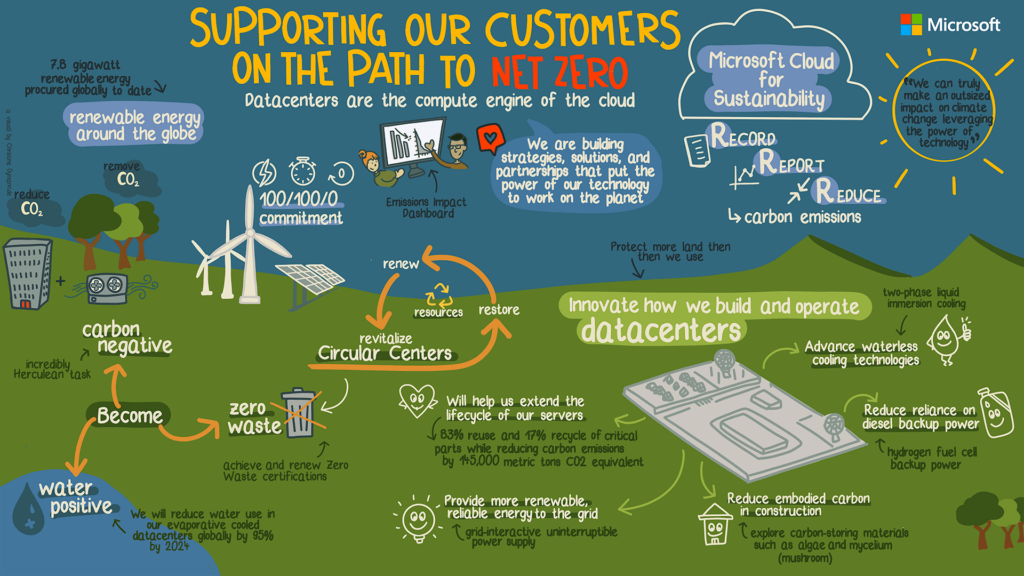Microsoft cloud for sustainability sets decarbonization aims

As world leaders discuss climate issues at the 2021 United Nations Climate Change Conference (COP26), big tech companies like Microsoft are also sharing their sustainability goals through innovations in the cloud and data centers. The changes aim to support customers on the path to net-zero, and further progress toward carbon negative by 2030.
“The increasing demand for cloud leads to increasing demand for data centers, which require power, land, and water to operate. We – and the cloud industry – face an important challenge as a result: scaling our computing power to progress digital economies, research, and inclusive economic opportunities – while also helping to preserve the only planet we have,” Noelle Walsh, corporate vice president of Cloud Ops and Innovation at Microsoft, outlined in a blog post.
For Microsoft, Walsh pointed out the aim is to allow organizations to more effectively record, report, and reduce their carbon emissions. And this is where the Microsoft Cloud for Sustainability comes in. It offers a comprehensive, end-to-end digital solution that helps organizations record their environmental footprint, report to stakeholders, and proactively reduce emissions on a path to net-zero.
“The Microsoft Cloud for Sustainability leverages the breadth of the Microsoft Cloud. It is a packaged Software as a Service (SaaS) solution that connects to data sources, accelerates data integration and reporting, provides accurate carbon accounting, measures performance against goals, and enables intelligent insights so organizations can take more effective action on sustainability. While the solution primarily supports emissions management today, there are plans to support water and waste in the future,” explained Microsoft president Brad Smith in a different blog post.
The Microsoft Cloud for Sustainability helps organizations advance the three critical processes that need to come together to achieve their sustainability goals. They are:
- Recording carbon emissions – automate data collection through connectors that can eliminate manual uploads through near real-time connections to emissions sources.
- Carbon reporting – have capabilities to analyze, visualize and report resource consumption, environmental impact, and sustainability progress, including to stakeholders, regulators, and the public.
- Carbon reduction – set and track incremental and long-term goals directly tied to data. The common data model enables enterprises to compare progress with peers that are also using Microsoft Cloud for Sustainability, identifying potential gaps in meeting regulatory requirements.

(Source – Microsoft)
At the same time, Microsoft also announced several key advanced development initiatives that will provide additional learnings and insights that can be taken into existing operations and help shape the future of the data center. These include:
- Reducing water use in data center operations by 95% by 2024 – create higher set points for a variety of different climates for when water-based, evaporative cooling is necessary to preserve server performance and reliability.
- Continued research in liquid immersion cooling, toward waterless cooling options -addresses the concept of overclocking, which is to operate chip components beyond their pre-defined voltage, thermal, and power design limits to further improve performance. Based on tests, Microsoft found that for some chipsets, the performance can increase by 20% through the use of liquid cooling.
- Data center design to support local ecosystems – understanding how an ecosystem performs on its own by quantifying ecosystem performance in terms of water quantity and quality, air, carbon, climate, soil quality, health and well-being, and biodiversity.
- Cutting carbon footprint in data center design and construction – using a tool called the Embodied Carbon in Construction Calculator (EC3) developed by the nonprofit Building Transparency. As a key initial step for all new data centers, Microsoft requires construction teams to use the EC3 tool to identify building materials that reduce embodied carbon.
With both governments and big tech companies making their pledges at COP26 to reduce carbon emissions and advocate climate issues, the goals set by the UN may just seem a possibility in the long run. Either way, both governments, and enterprises are realizing the importance of sustaining the environment.
As Smith puts it, “COP26 will provide an important moment for the world to take stock of where we all collectively stand. More important, it’s a moment that should inspire us to take new steps together. If one thing is clear, it’s this – we have a long and critical journey ahead!”










